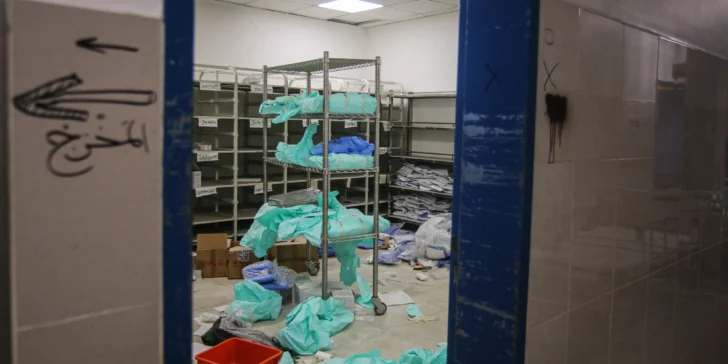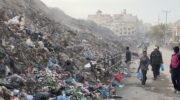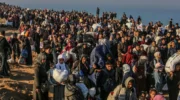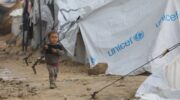According to the World Health Organization, at least 214 medical staff from Gaza have been detained by the Israeli military since October 7th. In early May, when Israeli authorities announced the death of well-known surgeon Adnan Al-Bursh, the world began to learn about the detention and alleged torture of Gazan medical professionals.
by Kavitha Chekuru, reposted from The Intercept, May 24 2024
Before late March, they had been in regular contact — or as regular as the shredded communication infrastructure would allow. Al Serr had created a telemedicine WhatsApp group where he and Osaid, a surgical resident in the U.S., recruited doctors from stateside, the U.K., and Europe to give advice to their overstretched colleagues in Gaza.
“He reported on a gunshot injury in a 70-year old,” Osaid said, of Al Serr. “It was in her head. And really, there were no neurosurgeons at that time.”
“He was sharing those cases, and he was asking for help,” Osaid went on. “It was like, ‘Is there any neurosurgeon that can help me? How can I fix this?’”
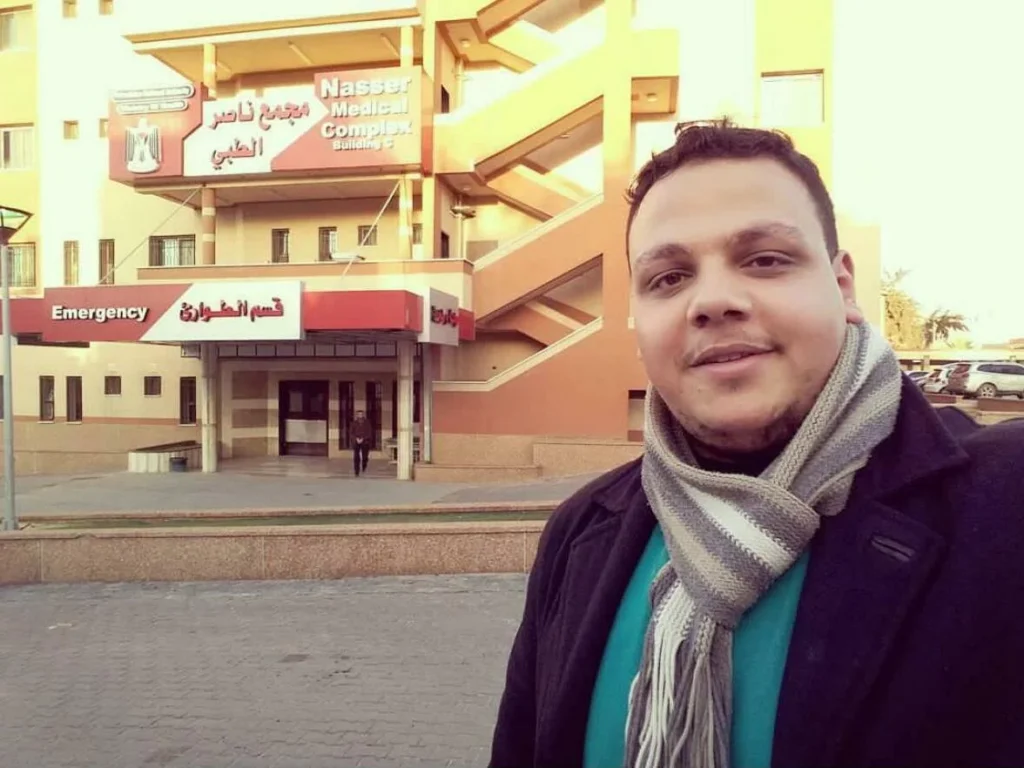
Al Serr was a natural vessel for the collective medical knowledge of the group chat. “He always wanted to help out, always liked to use his hands, to kind of fix a problem and have an immediate impact,” according to Osaid.
In February, the Israeli military invaded Nasser Hospital. The attack left the hospital hollowed out, just one of the destroyed health care centers in a medical system savaged by an overwhelming caseload and a relentless military assault by Israel.
Still, Al Serr maintained some optimism. His last post on Instagram was uploaded in mid-March, a short video showing the exterior of the hospital from the day before, captioned with a triumphant message:
Finally!! After more than a month of cutting electricity in Naser hospital, our staff was able to fix the generator and get the electricity again to Nasser Hospital. For the last two weeks, we are trying to clean and prepare the hospital’s departments to reopen the hospital again.
Six days later, on March 24, Israeli forces stormed the hospital again. Osaid had asked a few days earlier if Al Serr was alright. No response ever came. It was their last exchange.
His relatives believe that Khaled Al Serr, along with what was left of the hospital’s dwindling staff, was taken prisoner by Israel.
As early as November, reports emerged of doctors being detained and going missing in north Gaza. According to the World Health Organization, at least 214 medical staff from Gaza have been detained by the Israeli military. In early May, the detention and alleged torture of medical staff from Gaza made headlines when Israeli authorities announced the death of Adnan Al-Bursh, a well-known surgeon and the head of orthopedics at Al-Shifa Hospital. After being taken into custody in December, officials said Al-Bursh died in April while in Ofer Prison, an Israeli detention facility in the occupied West Bank.
“Dr. Adnan’s case raises serious concerns that he died following torture at the hands of Israeli authorities. His death demands an independent international investigation,” Tlaleng Mofokeng, the United Nations Special Rapporteur on the Right to Health, said in a statement last week. “The killing and detention of healthcare workers is not a legitimate method of warfare. They have a legitimate and essential role to care for sick and wounded persons during times of conflict.”
Al-Bursh is one of at least 493 Palestinian medical workers who have been killed in Gaza since October 7, according to the Ministry of Health. The Israel Defense Forces has systematically targeted hospitals from the north to the south of the strip, claiming that Hamas operates in the facilities. Medical staff in Gaza’s hospitals have repeatedly denied this claim. This week, Israeli forces have launched new attacks on Kamal Adwan Hospital and Al-Awda Hospital in the north, with reports on Wednesday and Thursday of medical staff being detained from Al Awda.
As ground troops made their way into southern Gaza by the end of the year, attacks on hospitals in the southern city of Khan Younis ramped up. In February, when the Israeli military was laying siege to Nasser Hospital, Al Serr was the only general surgeon there.
“He’s a very dedicated doctor,” Ahmed Moghrabi, a plastic surgeon who previously worked at Nasser Hospital, said of Al Serr.
Both doctors frequently posted to social media about the horrific cases that were flooding into Nasser Hospital, especially as attacks on the facility increased and international media coverage was scarce.
“I saw children, women in torn pieces,” Moghrabi told The Intercept, explaining why he began posting on social media. “I wanted to show the world what is going on on the ground.”
The last time he saw Al Serr was in February. “They” — the Israeli military — “surrounded the hospital and we were trapped,” Moghrabi recalled. “And the hospital came under siege for three weeks. We couldn’t really move from one building to another. We couldn’t have a look through the windows. Otherwise the snipers could shoot us.”
“We couldn’t have a look through the windows. Otherwise the snipers could shoot us.” — Ahmed Moghrabi, M.D.
Moghrabi left the hospital in mid-February, during the first invasion. “We evacuated at midnight that day,” he said. “The IDF established a checkpoint not far from the hospital gate. They checked everybody actually. My nurse, they took him at the checkpoint. He was detained for two months.”
As for Al Serr, Osaid said his cousin left shortly after the February evacuation to go to Rafah and check on his parents, but that he returned to Nasser Hospital to help reopen it and treat patients.
Since the attack on the hospital in late March, there’s been hardly any news about Al Serr. The only crumbs of information have been more alarming than reassuring. The first is that Al Serr was last seen signed into his WhatsApp in mid-April. “He was last active online on April 12,” Osaid said, “which, to me, tells me that they confiscated his phone and they basically accessed his phone as well.”
Then, a few days later on April 17, the news outlet Al Mayadeen released an interview with a Palestinian who identified himself as Ahmed Abu Aqel and said he had been detained and released by Israel. Moghrabi told The Intercept that Abu Aqel was previously a nurse at Nasser Hospital.
Clothed in a gray sweatshirt and sweatpants, a common outfit for released Palestinian detainees, Abu Aqel said he had a message from the doctors of Nasser Hospital who were being held in detention.
“They are subjected to daily beatings and killing and torture,” Abu Aqel said. “There is a message in particular from the doctor, Dr. Nahed Abu Ta’imah, director of surgery at the Nasser Medical Complex. His situation is very difficult and he is suffering under very difficult, tragic circumstances. He needs treatment and needs to be seen by the Red Cross and released urgently.”
“A colleague of mine was being held next to me,” Abu Aqel said. “His name was Khaled. They plucked his entire beard with pliers in front of me. His beard was plucked. This is one of hundreds I know.”
Osaid believes he is referring to Khaled Al Serr.
While Abu Aqel did not say where he was held — where Al Serr may still be — Osaid thinks it was likely Sde Teiman, a military base and detention center in Israel’s Negev Desert. There have been numerous allegations of abuse, torture, and detainees dying at Sde Teiman.
In a statement to The Intercept received after publication of this article, a spokesperson for the Israeli military did not answer specific questions about healthcare workers in detention, but denied any widespread abuse of Palestinians in custody. “The mistreatment of detainees during their time in detention or whilst under interrogation violates IDF values and contravenes IDF orders and is therefore absolutely prohibited,” the spokesperson said. “Concrete complaints regarding inappropriate behavior are forwarded to the relevant authorities for review.”
Aside from Abu Aqel’s vague testimony and the one blip on WhatsApp, there has been no information or updates on Al Serr’s whereabouts or condition.
“It’s just heartbreaking to know nothing about your loved ones,” Osaid said. “We don’t know if he’s alive or not. We don’t know if he’s OK or not.”
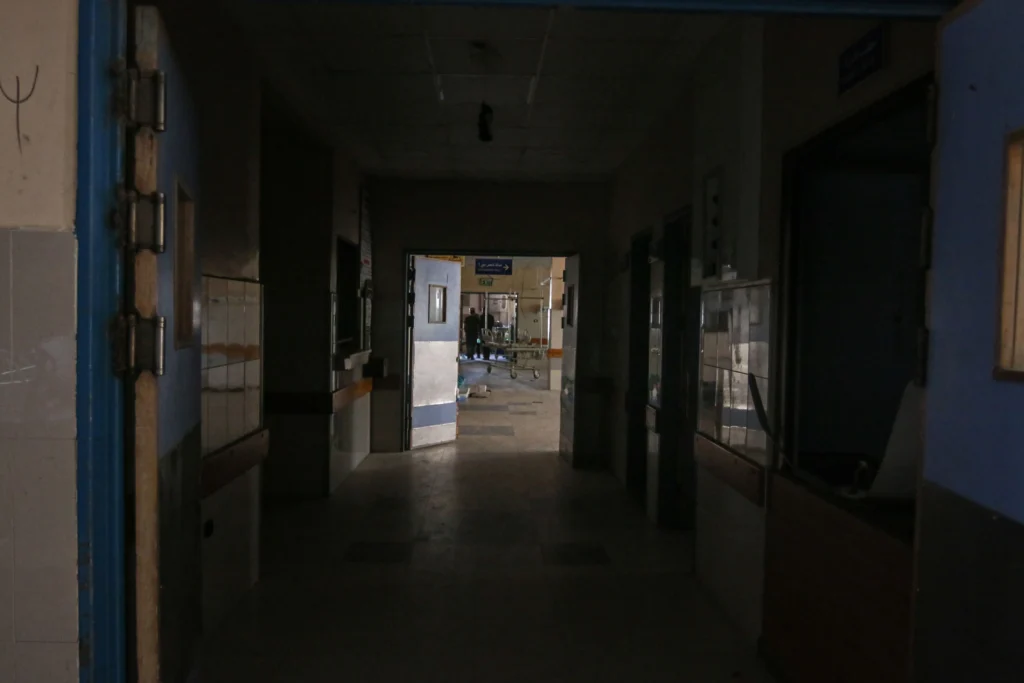
Those Palestinians lucky enough to be released from imprisonment offer harrowing glimpses of what happens inside Israeli detention centers.
In December, Khaled Hamouda, another surgeon, was working in Kamal Adwan Hospital in northern Gaza. A month earlier, he had been displaced from the Indonesian Hospital, where he normally practiced. At Kamal Adwan, Hamouda was also a patient, receiving treatment for injuries he sustained in an airstrike on his family home in Beit Lahia. His wife, daughter, father, and a brother, among other relatives, were killed in the attack.
It was about 10 days after the strike that Israeli forces ordered both medical staff and civilians sheltering at Kamal Adwan Hospital to leave. Hamouda said the hospital administration was told that people would be able to leave and go to a different hospital without being arrested.
That was not what happened. Hamouda and some of his colleagues were instead taken into custody by the Israeli military.
“When they attacked the hospital, they asked all the men and youth older than 15 years old and younger than 55 to hold their ID and to get out from the hospital,” Hamouda said. Their eyes were covered, their hands bound, and they were taken to another location, though Hamouda is not sure where.
Soon after they were taken, images began to spread on social media of dozens of detainees being held by Israeli soldiers in north Gaza. In one photo, a group of men stand shirtless in the foreground as a soldier appears to take their photo. It wasn’t long before people were able to identify one of the men as Hamouda.
עוד תמונה נוראית של המוני אזרחים, אומללים וחסרי כל, מרוכזים ומושפלים. גם עוד אלף “תמונות ניצחון” כאלו לא יעזרו לישראל לנצח. pic.twitter.com/cm1sIaiIQZ
— B.M. (@ireallyhateyou) December 12, 2023
“This is on the day they took us from Kamal Adwan hospital and they asked us to look at the camera,” Hamouda said. “It’s the only evidence that I was taken on this day. Nobody knew what happened to us until this photo went to the media.”
Hamouda said he was eventually taken to Sde Teiman, where he and other detainees were forced to remain on their knees. If they didn’t, they were punished. “They ask him to stand with his hand above his head for about three or four hours,” he said of one prisoner.
“Unfortunately, when they knew that I am a doctor and general surgeon, they treated me more badly.” — Khaled Hamouda, M.D.
“Unfortunately, when they knew that I am a doctor and general surgeon, they treated me more badly,” he recalled. “They attacked me, and they beat me in my back and my head.” Hamouda said the soldiers wanted to know if he knew about Israelis held captive in Gaza, but he didn’t know anything.
While he was detained, he also saw someone he knew from the medical community: Dr. Adnan Al-Bursh. “They brought Dr. Adnan in at about 2 or 3 a.m.. He was horribly treated. He was in pain,” Hamouda said. “He told me, ‘Khaled, they beat me. They attacked me violently.’” According to Hamouda, Al-Bursh also said he had a fractured rib. Hamouda was able to procure medicine and some food for Al-Bursh but, two days later, the injured doctor was taken away.
Despite his condition and the harsh circumstances of prison, Al-Bursh brought news for Hamouda. “Your mother is present in Al-Awda Hospital, and she is fine, I treated her,” Hamouda recalled Al-Bursh telling him. Hamouda was grateful for the message: “This information was very, very precious for me because I didn’t know any information about my family, specifically my mother. So I hugged him and kissed his head and thanked him because it’s the only hope that when I get out, I will find her.”
After three weeks, Hamouda was released. He told The Intercept he and other detainees were driven to the Kerem Shalom border crossing in the south and eventually went to Rafah. His surviving children and his mother were still in the north, and it would be two months before they were able to reunite. He considers himself fortunate because he was released.
“All my colleagues, doctors who were arrested with me or after me or before me, they kept them there for about three or four or five months,” he said. “Some are still being held.”
Even before the war, doctors were crucial in Gaza, especially amid the ebbs and flows of Israeli border restrictions and military attacks.
“Every two to three years,” Hamouda said, “we become trapped in some war or some attack from the Israeli Army. So our work is important for people who present there.”
Hamouda’s father had also been a doctor and wanted his son to follow in his footsteps. “He advised me to be a doctor,” Hamouda said, “because it’s a benefit to people.”
Fulfilling the necessity of caring for people, Hamouda believes, is why health care workers have become such common targets in this war. “It’s not a coincidence,” he said “They mean to attack the houses of the people who can treat the wounded people and that can change something in the condition in the north.”
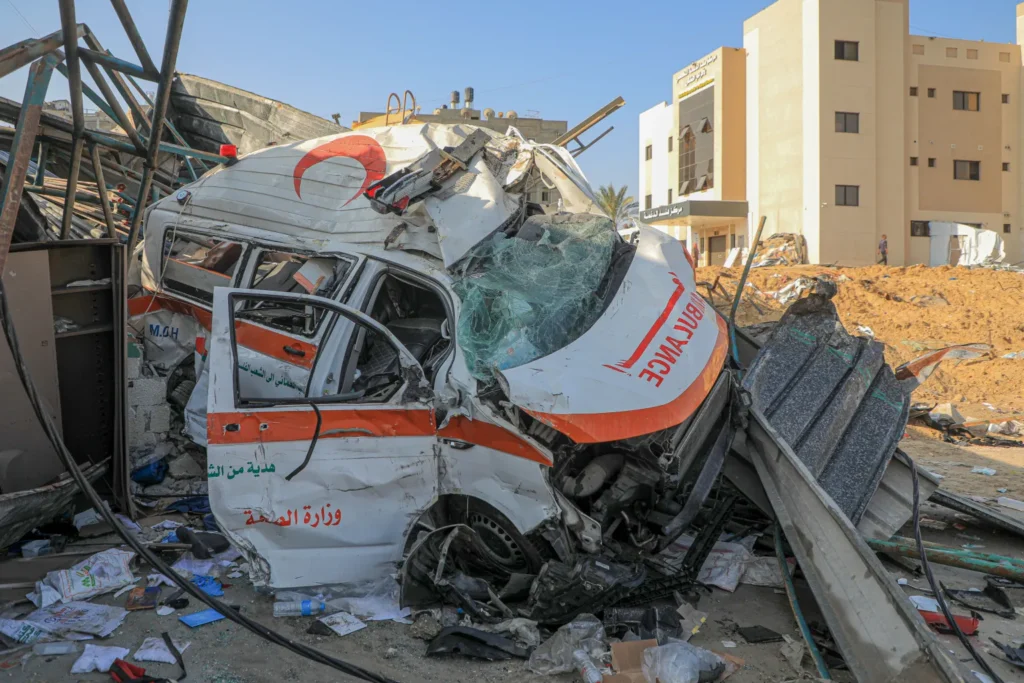
The sentiments were shared by Osaid, who said his cousin Al Serr would have agreed: They became doctors to help people. “With the amount of killing that has been going on for a while, we’re always in need for surgeons to fix traumatic injuries that people sustain,” Osaid said. “And so to me, [it] was a natural response growing up in Gaza, the desire of helping out and healing injured people.”
Al Serr’s posts on Instagram mostly show how he documented the flood of horrific cases that arrived in front of him: a steady stream of civilians torn apart by shrapnel and bullets, punctuated by repeated and escalating attacks on Nasser Hospital. One of his last posts, however, offered a glimmer of hope: two babies born on the day the hospital was invaded in February.
For his next post, Al Serr ventured outside the hospital, a reminder of how the war has left no one in Gaza untouched. It was a short video of his neighborhood, homes, and buildings turned to piles of rubble, with the path to his own home buried underneath it all.
“He always wanted to form a family,” Osaid said of his cousin, “have kids, build a life and live in peace.”
With no word from Al Serr for two months, that chapter of his life feels like an ever more distant possibility.
“He was very brave. He was doing his job. Pretty much our job as a surgeon is not just to heal the wounds and to fix wounds, but also to advocate for our patients. So he was advocating for them.”
“I really hope that he’s OK.”
Update: May 27, 2024
This article has been updated to include a statement from the Israeli military received after publication.
Kavitha Chekuru is a journalist with “Fault Lines,” Al Jazeera English’s award-winning news documentary show. Her reporting focused on human rights and security has been recognized with the George Polk award, the Overseas Press Club, the Society of Professional Journalists, and five News and Documentary Emmy nominations.
RELATED ARTICLES:- Hostages of Israeli revenge in the Gaza Strip: Testimonies of 100 released Palestinian detainees reveal crimes of torture, cruel treatment.
- Israel’s torture and humiliation of female and male Gazan prisoners.
- Testimonies from some of the 8,000 Palestinian children Israel has imprisoned.
- WATCH: Yes, Israel does arrest children [VIDEO].
- The writing was on the wall for Israel’s torture of prisoners.
- Strapped down, blindfolded, held in diapers: Israeli whistleblowers detail abuse of Palestinians in shadowy detention center.
- Palestinian Released From Israeli Prison Describes Beatings, Sexual Abuse and Torture.
- Israel holds thousands of Palestinian prisoners in solitary confinement despite health risks.
- Torture of Palestinian prisoners: Time to end Israel’s impunity.
- Palestinian woman on hunger strike against Israeli imprisonment & abuse.

